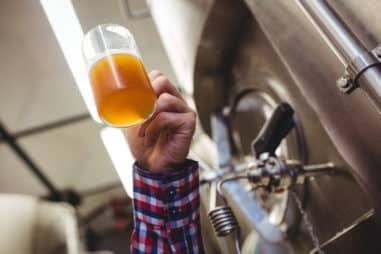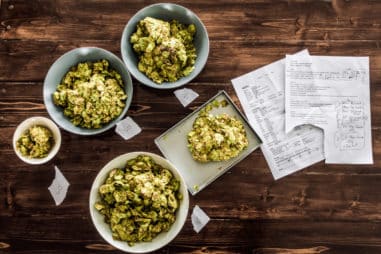Spontaneous Fermentation is an ancient practice first observed in nature. That was then controlled and emulated by man with all his ingenuity.
The simplicity of its setup hides the complexity of its inner workings. This is why by simply routing air you get a complex product at the end of a very, very long process.
Read this to get all the relevant information you need to know to turn a risky brew into a beer made by the elite few.
Is Fermentation Spontaneous or Nonspontaneous?
Fermentation can be Spontaneous, Nonspontaneous, or both. This process does not have to be segregated into binary bins.
It actually is a very analog technology that started out as spontaneous. This then evolved into nonspontaneous, aka the introduction of cultured microbes. Then ultimately, brewers decided to get the best of both worlds by doing hybrid methods.
What Is Spontaneous Fermentation?
For fermentation to be called “Spontaneous,” you must let your wort be passively enriched by local bacteria and yeast. Their metabolic processes convert sugars into alcohol, like the way mainstream lab-grown bugs do.
It is called spontaneous because it just happens out of nowhere — like magic. And like magic, a multitude of flavors “pop” out of seemingly nothing, resulting in a complex piece of work.
What Is Open Spontaneous Fermentation?
Spontaneous Fermentation is done using open vessels. This facilitates the influx of the environmental elements that make the unique beverage.
The term “open” does not really describe any unique method by which spontaneous fermentation is conducted. It should therefore not be mixed up with “open fermentation” and “open-top fermentation.” These are more fermentation methodologies than a type of fermentation.
Why Does Spontaneous Fermentation Happen?
Microorganisms are omnipresent lifeforms in your everyday existence. They exert their influence through things like Spontaneous Fermentation, a very natural occurrence. It is one of the reasons why fruits and vegetables turn from fresh to rotten.
Now, why does this happen? You could say that it is the natural order of things. Nature’s garbage collection, if you will.
If the aforementioned is too philosophical of an explanation for you, there is another way to look at it.
Contemporary beer fermentation is done using isolated strains of yeast. These yeasts are nothing more than stuff existing in the environment that makes alcohol for a living. Humans just sequestered them for their beer-making purposes.
Spontaneous fermentation is simply setting up an all-you-can-eat buffet for these “unchained” microorganisms. And in human fashion, such actions are motivated by beer-making.
Advantages and Disadvantages of Spontaneous Fermentation
As with anything, there are always pros and cons. You must always remember to be mindful of the naturalistic fallacy. Not all things labeled “natural” are always good.
Advantages
Complexity of Flavors, Aromas, Textures. Taste, Smell, and Feel the following:
- Barnyard, Leathery, Medicinal, Clove,
- Sour, Acidic, Tart, Vinegary
- Butterscotch, Buttered Popcorn
Some aspects are more welcome for a “good” beer than others.
Disadvantages
- Slow Starting. You do not have direct control of the volume of microorganisms in the environment. Hence, the minimum amount to start the process at a reasonable time can be tough to achieve.
- Slow Fermentation. Naturally occurring microbes are not as performance-optimized as isolated strains, so don’t expect them to work as fast.
- Undesirable Byproducts. Certain microorganisms can produce off-flavors at certain times during fermentation. Ideally, everything should clear up given enough time, but depending on your recipe and patience, things can go awry.
Yeast in Spontaneous Fermentation
Spontaneous Fermentation is not limited to yeasts. It is a combination of multiple species of microbes working in parallel and in series. A kind of harmonious working relationship.
It is diverse on so many levels. It varies from location to location, brewery to brewery, and batch to batch.
The most prominent of the brewing team are:
- Enterobacter Clocae, Klebsiella Aerogenes
- Acetobacter, Gluconobacter, Oxidative Yeasts
- Saccharomyces Cerevisiae
- Pediococcus and Lactobacillus
- Brettanomyces Bruxellensis
And other less-influential microorganisms whose names are very familiar but not worth mentioning.
How Do You Do Spontaneous Fermentation?
There is not really much you need to do when it comes to facilitating Spontaneous Fermentation. It should be simple and straightforward. Not unless you are doing a hybrid method or actively inoculating your wort with pre-formulated cultures.
Here is an excerpt from making basic Lambics from the official Méthode Traditionnelle:
- Wort is cooled in an open-top coolship. At least 50% of the wort should be used. The cooling starts from near-boiling all the way down to room temperature.
- Expose your brewing vessel to untreated fresh air. Close to an open window/s will do nicely.
- Exposure should last between 8-16 hours.
Adding microbes is forbidden at any point for it to be 100% spontaneous fermentation. No cheating.
After doing the basic setup, transfer the wort to your primary fermentation vessel to continue.
If you insist on doing the active inoculation with comparable bacteria and yeast, it is done in multiple steps. The execution can be quite complicated, and it is beyond this article’s scope.
How Long Does Spontaneous Fermentation Take?
After exposing the wort to nature and transferring it to undergo the full fermentation process, you will have to wait a rough minimum of six months. And depending on the recipe, it can take one, two, or three years to complete. Take for example Belgian Lambics.
Beer made with this type of fermentation, even though easy to start up, is notoriously difficult to finish to an acceptable level of quality. This is the reason why not very many brewers bother with such a challenging risk-reward ratio.
Which Beer Style Is the Result of a Spontaneous Fermentation?
Plenty of beer styles come from Spontaneous Fermentation. This is because this kind of fermentation has been around ever since the discovery of alcoholic beverages itself. So, the oldest classes of beers are spontaneously fermented in some way, shape, or form.
Here is a short listing to give you a general idea:
“Lambic, Wood-Aged Ale, Old Ale, Gose, Flanders, Saison, Gueuze, Sour Ales, Brett Ales”
Semi-spontaneous Fermentation
There are no fully-defined rules when it comes to the naming and scope attributed to Spontaneous Fermentation. This includes methods that attempt to extract the advantages of traditional methods and combine them with the mainstream ways.
Whether they should still be in the same class as pure Spontaneous Fermentation is debatable. Regardless, Semi-spontaneous Fermentation can be boiled down to a combination of:
- Open Cooling for spontaneity,
- Pitching Laboratory Microbes to get precise targeting of character,
- AND/OR Reusing Existing Cultures from bottle dregs or funk deeply entrenched in used wooden vessels
The topic of what technically constitutes spontaneity has become quite muddied. It has even been taken advantage of by marketers. Think of the hype surrounding all-natural and organic shenanigans.
Lactic Acid Spontaneous Fermentation
In the world of beer, “true” Spontaneous Fermentation involves the process of Lactic Acid production. It is a process part and parcel of the grand scheme of this type of fermentation. This creates that distinct mouth-puckering experience.
There is no such thing as 100% lactic acid bacteria creating beer. This is because their metabolism works to produce lactic acid instead of alcohol. It is useful for other applications like making kimchi, as an example.
Milk the Funk Spontaneous Fermentation
Milk the Funk (MTF) is not a form of Spontaneous Fermentation, rather, it is a community knowledge base. It presents truth-seekers such as yourself with the archived accumulated knowledge of homebrewers. Their mission is focused on sharing information, techniques, tips, and tricks on alternative ways of brewing.
If you want to take a deeper dive into Spontaneous Fermentation, you can study their wiki.








